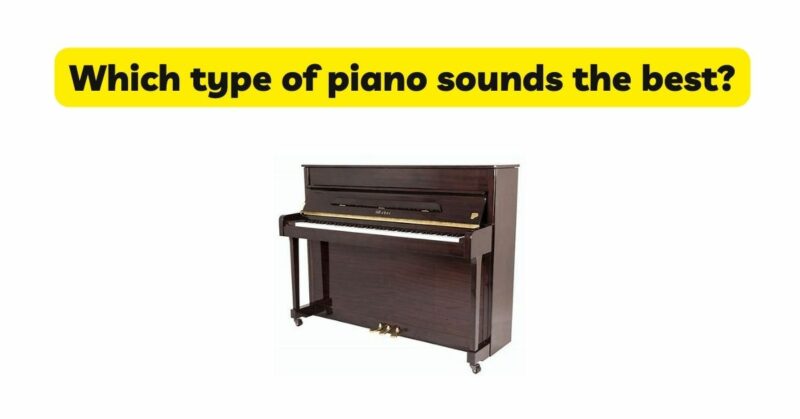The pursuit of finding the piano that sounds the best is a never-ending journey for pianists, enthusiasts, and music lovers. The sound quality of a piano is influenced by various factors, including design, construction, materials, and individual instrument variation. In this article, we embark on a sonic exploration to uncover the nuances and complexities of piano sound. By examining the sound characteristics of different piano types, such as grand pianos, upright pianos, and digital pianos, we aim to shed light on the quest for the piano that sounds the best.
- Grand Pianos: Epitome of Sonic Excellence: Grand pianos have long been revered as the pinnacle of sonic excellence in the piano world. Their horizontal string orientation, larger soundboards, and intricate craftsmanship contribute to their exceptional sound quality. Grand pianos are known for their rich, resonant, and expressive sound, with a wide tonal palette and dynamic range. The longer strings and expansive soundboard area allow for greater tonal depth, complexity, and sustain. The luxurious sound and sonic versatility of grand pianos make them a favored choice for concert halls, professional pianists, and those seeking the utmost sonic excellence.
- Upright Pianos: Warmth and Charm: Upright pianos, with their vertical string arrangement and compact design, offer a distinct sonic experience. While they may not match the tonal complexity and resonance of grand pianos, upright pianos possess their unique warmth, character, and charm. The vertical string arrangement and smaller soundboard contribute to a more focused and intimate sound. Upright pianos often excel in producing warm and mellow tones that can be well-suited for genres such as jazz, popular music, and intimate performances. The affordability and accessibility of upright pianos also make them a popular choice for many pianists and music enthusiasts.
- Digital Pianos: Technological Marvels: Digital pianos have made significant advancements in replicating the sound and feel of acoustic pianos. These instruments utilize electronic technology to produce piano sounds and offer a range of features and functionalities. High-quality digital pianos employ advanced sampling techniques to capture the nuances and characteristics of acoustic pianos. While digital pianos may not possess the same level of sonic depth and resonance as acoustic pianos, they provide versatility, portability, and the ability to replicate a variety of piano sounds and other instrument sounds. Digital pianos can be an excellent choice for those seeking convenience, flexibility, and access to various sounds and features.
- Individual Instrument Variation: It is crucial to note that individual instruments within each piano type exhibit variations in sound quality. Each piano possesses its unique sonic profile, influenced by factors such as brand, model, age, maintenance, and condition. Even among grand pianos or upright pianos, two instruments of the same model can produce subtly different sounds. Therefore, it is essential for pianists to try different instruments, evaluate their tonal qualities, and choose the one that resonates with their musical preferences and artistic vision.
- Personal Preference and Musical Context: The determination of which type of piano sounds the best ultimately depends on personal preference and the specific musical context. Sound is a subjective experience, and what may be considered the best sound by one person may not resonate similarly with another. Personal taste, musical style, and repertoire can all influence the preference for a particular piano sound. The intended musical context, whether it’s a concert hall, recording studio, home practice, or live performance, also plays a role in choosing the best-suited piano type. It is important for pianists to consider their individual preferences, musical goals, available space, and budget constraints when determining the piano that sounds the best for their specific needs.
- The Unattainable Ideal: While the quest for the piano that sounds the best is an intriguing endeavor, it is essential to recognize that the notion of “best” is subjective and elusive. Sound preferences vary among individuals, and there is no universally agreed-upon standard for the best sound. The beauty of the piano world lies in the diverse array of sounds and tonal possibilities offered by different piano types. Each type of piano, whether grand, upright, or digital, possesses its unique sonic qualities and serves different musical purposes. Embracing this diversity allows pianists to explore, appreciate, and celebrate the richness and depth of piano sound.
Conclusion: The search for the piano that sounds the best is a complex and subjective quest. Grand pianos are often hailed for their exceptional sound quality, tonal complexity, and dynamic range. Upright pianos offer a distinct warmth, character, and charm that appeals to certain genres and musical styles. Digital pianos provide technological advancements and versatility in sound replication. The determination of the best-sounding piano depends on personal preference, musical context, and individual instrument variation. Rather than striving for an unattainable ideal, embracing the diverse sounds and tonal possibilities offered by different piano types allows pianists to find the instrument that resonates with their artistic vision, musical aspirations, and unique sonic preferences.

